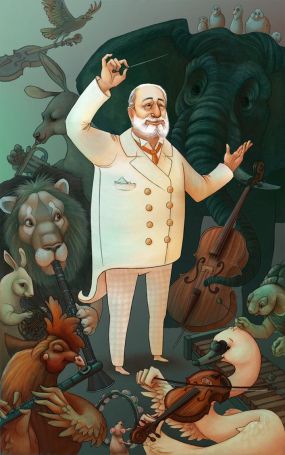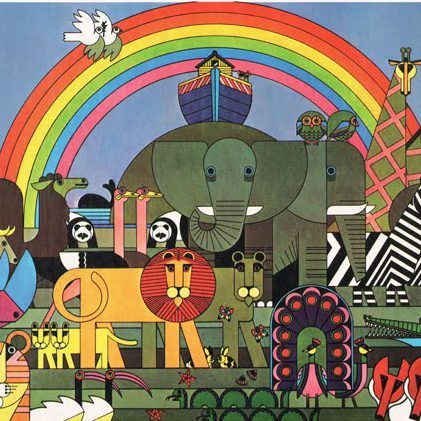A prodigy who made his concert debut at the age of 10, the French Romantic composer and conductor Charles-Camille Saint-Saëns (1835-1921) studied music at the Paris Conservatory (founded in 1795) and after a career as a church organist and teacher, shot to international fame in the 1880s. He was, in the words of the prolific Hungarian composer Franz Liszt (1811-1886), “the world’s greatest organist”.
An avid traveller, Saint-Saëns wrote his famous musical suite The Carnival of the Animals (Le carnaval des animaux) while on vacation in Austria in 1886. It is said that Saint-Saëns believed that the humorous fantasy score – which was meant for a small orchestra of two pianos, two violins, viola, cello, bass, flute, clarinet, harmonium, xylophone and celeste – was too frivolous to be published during his lifetime. For this reason, he only gave private performances of the suite to close friends.
The Carnival of the Animals (about 25 minutes long) consists of fourteen movements and a finale:

I. Introduction et marche royale du lion (Introduction and Royal March of the Lion)
II. Poules et coqs (Hens and Roosters)
III. Hémiones – animaux véloces (Wild Asses – quick animals)
IV. Tortues (Tortoises)
V. L’éléphant (The Elephant)
VI. Kangourous (Kangaroos)
VII. Aquarium
VIII. Personnages à longues oreilles (Characters with Long Ears)
IX. Le coucou au fond des bois (The Cuckoo in the Depths of the Woods)
X. Volière (Aviary)
XI. Pianistes (Pianists)
XII. Fossiles (Fossils)
XIII. Le cygne (The Swan)
XIV. Finale
Many of these pieces have been widely used in films and video games, particularly “Aquarium”.
In the book Camille Saint-Saëns: A Life, biographer Brian Rees explains in depth, getting a little technical:
The fourteen short movements which comprise Carnival are remarkably varied. In the ‘March of the Lion’, Saint-Saëns specified ‘style persan’ [persan is ‘Persian’ in French] as leonine roars shared the Dorian mode with parts of the Mélodies persanes [another work of Saint-Saëns’]; the ‘Poules et Coqs’ followed the examples of Rameau and other bird noise experts, ‘Hermiones’ employed rapid piano runs to suggest the wild gallops of this somewhat untraceable species, the ‘Tortoises’, represented by the Galop from Offenbach‘s Orpheus in the Underworld played adagio, continue on their obstinate way oblivious to all harmonic obstacles and, in the manner of the fable, reach their goal. The ‘Elephant’ is pure parody with the double-bass lumpenly murdering Berlioz‘s ‘Dance of the Sylphs’, with allusions to Mendelssohn and Meyerbeer‘s Les Patineurs thrown in. The ‘Aquarium’ is a highly impressionistic piece with its mixture of celeste, piano and violin sounds, which even Debussy might have thought adventurous. The ‘large-eared’ asses make braying sounds but poetry returns with the ‘Cuckoo’, where string passages suggest limitless forests from whose depths the solitary cuckoo sounds. Flutes, as custom dictates, people the aviary and then, surprisingly, come the ‘Pianists’ practising Czerny-like exercises and reminding the listeners that, for a composer, piano players in a neighbouring apartment are troublesome beasts. The fossils are both real and metaphorical: skeletons from the Danse Macabre [another famous piece by Saint-Saëns’] jostle with musical relics, which include a Rossini aria and songs such as ‘J’ai du bon tabac’. Another change of mood introduces ‘The Swan’, where the lines of the melody suggest the graceful contours of the swan’s neck, which, despite its many versions, is best heard as the cello solo, while the two pianos magically suggest the ripples and water-drops of river foliage through which the majestic creature glides. The Finale harks back to the mood of the Second Empire, a ‘carnival’ in its way, and various figures from the bestiary join in a ‘can-can’ romp. The suite displayed his interest in new instruments, for it was in 1886 that the celeste was first displayed by Alphonse Mustel.
Here is a near-perfect rendition of the Carnival by London-based Royal Philharmonic Orchestra. Those of you who can read music will love this!
In 1949, the American poet Ogden Nash (1902–1971) wrote a set of funny verses to accompany each movement for a Columbia Masterworks recording of the Carnival of the Animals. Here are they –
Introduction Camille Saint-Saëns Was wracked with pains, When people addressed him, As Saint Sanes. He held the human race to blame, Because it could not pronounce his name. So, he turned with metronome and fife, To glorify other kinds of life. Be quiet please - for here begins His salute to feathers, fur, and fins. Royal March of the Lion The lion is the king of beasts, And husband of the lioness. Gazelles and things on which he feasts Address him as your highoness. There are those that admire that roar of his, In the African jungles and velds, But, I think that wherever the lion is, I'd rather be somewhere else. Hens and Roosters The rooster is a roistering hoodlum, His battle cry is "cock-a-doodleum". Hands in pockets, cap over eye, He whistles at pullets, passing by. Wild Asses Have ever you harked to the jackass wild, Which scientists call the onager? It sounds like the laugh of an idiot child, Or a hepcat on a harmoniger. But do not sneer at the jackass wild, There is a method in his heehaw. For with maidenly blush and accent mild The jenny-ass answers shee-haw. Tortoises Come crown my brow with leaves of myrtle, I know the tortoise is a turtle, Come carve my name in stone immortal, I know the turtoise is a tortle. I know to my profound despair, I bet on one to beat a hare. I also know I'm now a pauper, Because of its tortley, turtley, torper. The Elephant Elephants are useful friends, Equipped with handles at both ends. They have a wrinkled moth-proof hide. Their teeth are upside down, outside. If you think the elephant preposterous, You've probably never seen a rhinosterous. Kangaroos The kangaroo can jump incredible, He has to jump because he is edible. I could not eat a kangaroo, But many fine Australians do. Those with cookbooks as well as boomerangs, Prefer him in tasty kangaroomeringues. Aquarium Some fish are minnows, Some are whales. People like dimples, Fish like scales, Some fish are slim, And some are round, They don't get cold, They don't get drowned. But every fishwife Fears for her fish. What we call mermaids They call merfish. People With Long Ears In the world of mules There are no rules. The Cuckoo in the Middle of the Wood Cuckoos lead bohemian lives, They fail as husbands and as wives, Therefore, they cynically dispariage Everybody else's marriage. Aviary Puccini was Latin, and Wagner Teutonic, And birds are incurably philharmonic, Suburban yards and rural vistas Are filled with avian Andrew Sisters. The skylark sings a roundelay, The crow sings "The Road to Mandalay," The nightingale sings a lullaby, And the sea gull sings a gullaby. That's what shepherds listened to in Arcadia Before somebody invented the radia. Pianists Some claim that pianists are human, And quote the case of Mr Truman. Saint Saëns, upon the other hand, Considered them a scurvy band. A blight they are, he said, and simian, Instead of normal men and womian. Fossils At midnight in the museum hall, The fossils gathered for a ball. There were no drums or saxophones, But just the clatter of their bones, A rolling, rattling carefree circus, Of mammoth polkas and mazurkas. Pterodactyls and brontosauruses Sang ghostly prehistoric choruses. Amid the mastodonic wassail I caught the eye of one small fossil, "Cheer up sad world," he said and winked, "It's kind of fun to be extinct." The Swan The swan can swim while sitting down, For pure conceit he takes the crown, He looks in the mirror over and over, And claims to have never heard of Pavlova. Finale Now we've reached the grand finale, Animale carnivale. Noises new to sea and land, Issue from the skillful band. All the strings contort their features, Imitating crawly creatures. All the brasses look like mumps From blowing umpah, umpah, umps. In outdoing Barnum and Bailey, and Ringling, Saint-Saëns has done a miraculous thingling.
Sometime in the 1970s, a Looney Tunes episode was released with Daffy and Bugs playing the score and reciting the verses too:
—-
Further Reading:
The Carnival and the Animals (Books & CD) (2010) by
—-
Image Credit:
Featured: “05 Cliff Richards, Carnival of the Animals” by User “Will”, CC BY 2.0, Flickr
—-
![]()

Wonderful recording !
LikeLiked by 1 person